CyberPowerPC FangBook Gaming Notebook Review
by Dustin Sklavos on May 1, 2013 12:01 AM ESTSystem Performance
Unfortunately due to our refresh, this section is a little truncated, but I'm hoping it will at least be somewhat enlightening. My primary interest here is in the comparison between the NVIDIA GeForce GTX 675M and the GTX 675MX, and secondary is the mild evolution from the Intel Core i7-3610QM to the i7-3630QM. Until we get some more gaming notebooks in (and we do have more on the way), you're going to see this gaming behemoth tussling with notebooks well below its weight class.
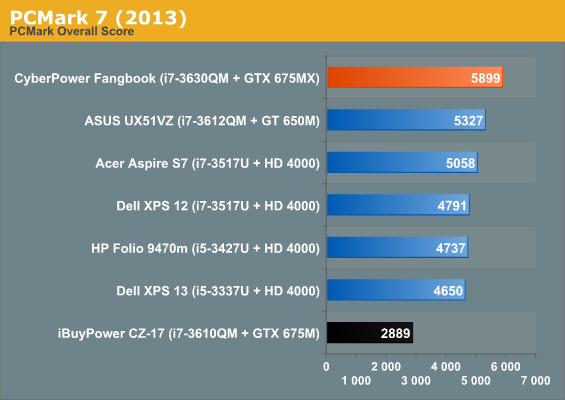
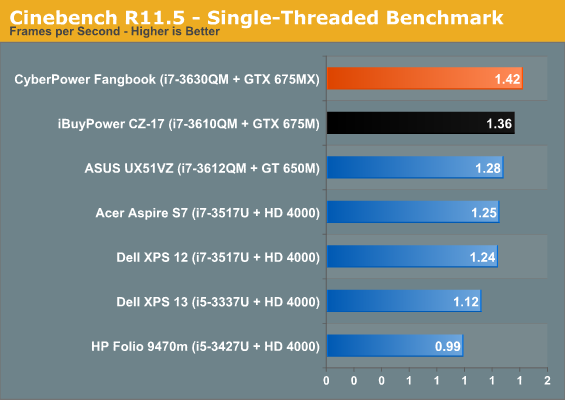
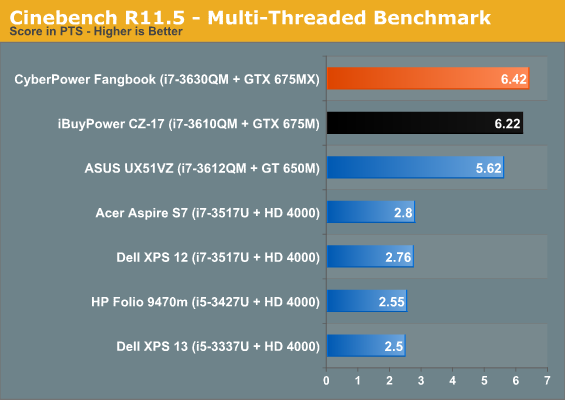
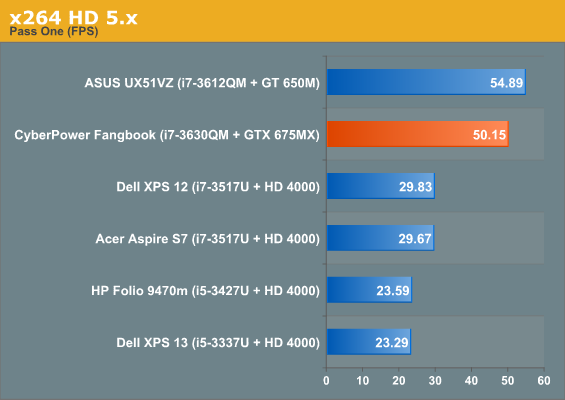

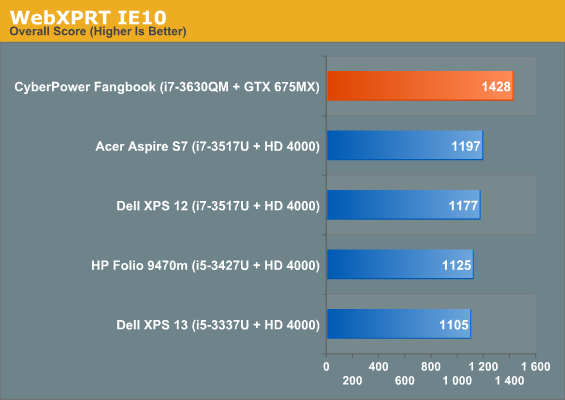
Our CPU-based benchmarks are unsurprising since the i7-3630QM in the FangBook is fighting it out with dual core processors running at a third of the voltage. The 3630QM's improvement on the 3610QM is as incremental as you'd expect; note that in PCMark 7, the Valkyrie falls well behind. That's due to the Valkyrie not shipping with an SSD standard at the time, which hamstrings performance in PCMark.
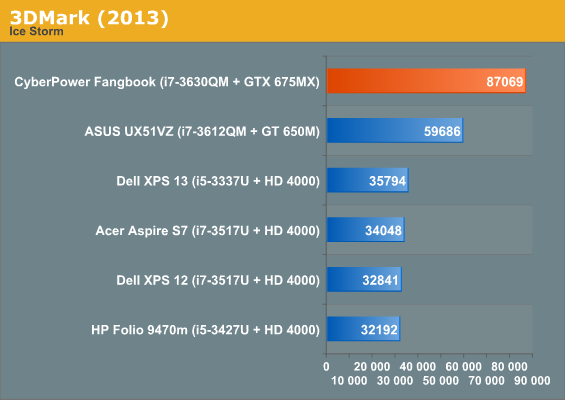

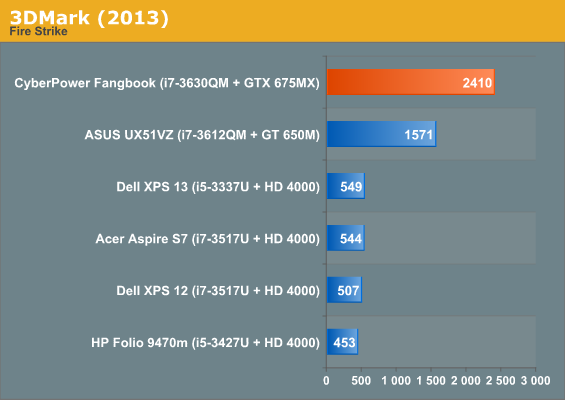
Remember that Intel optimizes for 3DMark, so their best case scenario is being a third as fast as a 100W dedicated GPU. In practice it's obviously a much bigger difference.
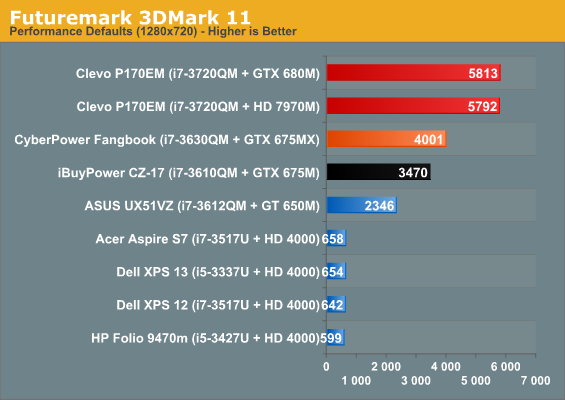
Until we have more results from gaming notebooks in our new testbed, we're kind of stuck with 3DMark 11 to tell us the story, and it's an interesting but unsurprising one. First, the GTX 675MX is about 115% as fast as the GTX 675M, which is a decent jump and roughly around what we should expect. What's more interesting is the absolutely staggering gulf between the 675MX and the 680M and AMD Radeon HD 7970M. This isn't surprising; the 680M is a GK104 with just one shader cluster disabled, so it should be running roughshod on the 675MX. This speaks to a need for NVIDIA to have something to bridge that gap, though. The 675MX isn't even hanging out in the 680M's neighborhood, but unfortunately it's the fastest chip CyberPowerPC will sell you in the FangBook. Interestingly, iBuyPower can't beat it, but AVADirect will sell you an identically configured notebook with the same chassis and a 680M for another $400. That kind of pricing won't set the world on fire, but if you want the best mobile gaming experience you can get before going multi-GPU, the 680M is probably worth the money.
We know how the 675M and 675MX compare to each other in synthetics, but how do they stand in practice? As it turns out, the gulf between them isn't particularly wide. Note that the stand-in for the 675M is my own Alienware M17x R3 with an i7-2720QM and GTX 580M. Since the 580M and 675M are nigh identical, this is a valid comparison, though my CPU is a generation behind and slightly slower than the FangBook's. All of these results use NVIDIA's beta 320.00 drivers.
|
1366x768 Medium Settings |
675M | 675MX | % Gain |
| Bioshock Infinite | 96.5 | 107.3 | 11.2% |
| Skyrim | 87.1 | 99.5 | 14.2% |
| Sleeping Dogs | 93.3 | 106.4 | 14% |
| StarCraft II: HotS | 59.5 | 66.3 | 11.4% |
| Tomb Raider | 136.2 | 137.6 | 1% |
At these settings all of the games are very playable, so there's no real news to report here. It's interesting to note that Tomb Raider appears to be CPU limited here, though.
|
1600x900 High Settings |
675M | 675MX | % Gain |
| Bioshock Infinite | 57 | 62.4 | 9.5% |
| Skyrim | 69.3 | 75.5 | 8.9% |
| Sleeping Dogs | 64.5 | 76.7 | 18.9% |
| StarCraft II: HotS | 54.2 | 59.8 | 10.3% |
| Tomb Raider | 72.6 | 77 | 6.1% |
Put a little more stress on the GPUs, and they...reduce the gap? At 1600x900, performance gains drop for three of the games. Only Sleeping Dogs and Tomb Raider see improvements.
|
1920x1080 Ultra Settings |
675M | 675MX | % Gain |
| Bioshock Infinite | 28 | 35.6 | 27.1% |
| Skyrim | 53.9 | 58.2 | 8% |
| Sleeping Dogs | 33 | 36.8 | 11.5% |
| StarCraft II: HotS | 44 | 51.1 | 16.1% |
| Tomb Raider | 21.3 | 22.1 | 3.7% |
Improvements really depend on the game you're playing, but the GTX 675MX isn't the vastly superior chip we were expecting. While it's consistently faster than the GTX 675M (as it should be), it's not fast enough to merit seeking out if you already have a 580M/675M. I was honestly expecting and hoping for a more robust improvement, but the difference is fairly incremental.
Given that these are extremely high end GPUs, aftermarket ones aren't as difficult to find. I had a 680M running in my M17x R3 for a little while, and it definitely can be done and done stably (though you do sacrifice Optimus). If you're operating on last generation's top end, like the 580M or the HD 6990M, a jump to an HD 7970M or 680M will absolutely produce a substantial gaming improvement. It's the more incremental upgrades like the 675MX that are less attractive.










24 Comments
View All Comments
kjohio - Wednesday, May 1, 2013 - link
Excellent observation. Heat is definitely a big issue while playing games. Would love to have any updates on this topic. Thanks,darkhawk1980 - Friday, May 3, 2013 - link
Since this chassis is based off the older MSI GT70, the most likely cause is that it has the same problems the GT70 did in production, and that the heatsink compound and heatsinks were not done properly, do you were not getting efficient cooling. After re-applying compound and remounting the heatsinks, it should be better. Atleast, if this is based on the GT70 as much as it looks like. They could have skimped on the heatsink more than MSI did, which might help explain the heat issues.whyso - Wednesday, May 1, 2013 - link
Does the 7950m even exist? I've never seen it.cknobman - Wednesday, May 1, 2013 - link
I'd rather have the MSI GX60 for $1200.It boasts a 7970m and is overall a nicer laptop.
TH did a review on it yesterday and while it lacked the raw cpu horsepower of some of the intel models the review proved that when it came to games it really did not make that big of an impact and it could still play everything at max settings on 1920x1080. It also had pretty decent battery life.
Bob Todd - Wednesday, May 1, 2013 - link
That's actually a very interesting gaming laptop. I love the tear down pics of the cooling design. CPU performance obviously isn't earth shattering but about the only intensive thing I do on my laptop these days is playing the occasional game anyway. I wish they made a more subtle looking version. Also, I checked the usual places and the versions they are selling lack the dual mSATA RAID 0 array. It's still a good deal of gaming performance for the money, but the SSDs would make it a pretty phenomenal piece of gaming kit for the money.DanNeely - Wednesday, May 1, 2013 - link
Consumer SSD raid0 is a benchmark chasers/suckers gimmick only. You won't notice the performance difference vs a single larger drive any more than you will the difference between a cheap and high performance SSD.You will however have doubled your risk of losing data to a drive failure.
Bob Todd - Wednesday, May 1, 2013 - link
Understood, and I don't really care that it's set up as a RAID 0 array. What I'm really after is just mSATA (or NGFF now) + 9.5mm HDD. I'll gladly give up a few millimeters in any laptop for a full height HDD. Newegg had the HGST 1TB drives for $65 for quite a while. That plus a 256GB mSATA is an ideal setup for me. Unfortunately Lenovo seems to be the only manufacturer including mSATA/NGFF support into most of their lineup. And I wouldn't really care if they throw two mSATA drives in RAID 0. I have sysprep'd OS images set up how I want them, and anything important goes to a home server with 2 disk redundancy, with the stuff I really care about in the cloud as well. I screw around with my hardware enough that wiping the system drives on any of them isn't going to make me lose any sleep. If one of the mSATA drives died I'd just replace it and restore from the last daily backup.Majes - Wednesday, May 1, 2013 - link
I was pretty dissapointed in the MSI GX60... The video card did not switch as advertised for some of my games, and was quite a hassle to deal with. Would have rather they just put in the 7970m as a dedicated card than do all the switching based on program. I returned my laptop in less than a week I was so dissatisfied.My two cents anyway :-/
will54 - Wednesday, May 1, 2013 - link
notebookcheck reviewed the GX60 a while back and the CPU bottlenecked the GPU so bad that some games were below the 660M and 3630QM.whyso - Thursday, May 2, 2013 - link
The a10 bottlenecks quite badly. It can be seen in the toms hardware review or the notebookcheck review. Even looking at the bf3 singleplayer benchmarks we see a cpu problem at lower settings (and looking at other bf3 reviews practically any cpu will not bottleneck bf3 singleplayer). BF3 multiplayer is going to kill this thing. Hitman is flat out unplayable. You can see a lot in that review that in a lot of games you are limited to only 40-50fps in current and old games, as hardware requirements rise you are going to be cpu limited to 30 fps or below.In my opinion gpu bottleneck is much preferable to cpu bottleneck. You can always work around a gpu bottleneck but a cpu bottleneck is much harder. Its better to have a laptop than can play all games on average settings than one that can play 75% of games on high and 25% not at all.